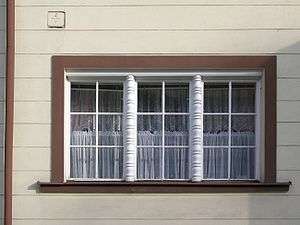Muntin
A muntin (US), muntin bar, glazing bar (UK) or sash bar is a strip of wood or metal separating and holding panes of glass in a window.[1] Muntins can be found in doors, windows and furniture, typically in western styles of architecture. Muntins divide a single window sash or casement into a grid system of small panes of glass, called "lights" or "lites".
.jpg)
In UK use a muntin is a vertical member in timber panelling or a door separating two panels.
Windows with "true divided lights" make use of thin muntins, typically 1/2" to 7/8" wide in residential windows, positioned between individual panes of glass. In wooden windows, a fillet is cut into the outer edge of the muntin to "stop" the pane of glass in the opening, and putty or thin strips of wood or metal are then used to hold the glass in place. The inner sides of wooden muntins are typically milled to traditional profiles. In the U.S., the thickness of window muntins has varied historically, ranging from very slim muntins in 19th century Greek revival buildings to thick muntins in 17th and early 18th century buildings.
Until the middle of the 19th century, it was economically necessary to use smaller panes of glass, which were much more affordable to produce, and fabricate into a grid to make large windows and doors.[2] Many considered the division of a window or glazed door into smaller panes to be more architecturally attractive than use of large panes. In the UK and other countries, muntins (typically called "glazing bars" in the UK, or "astragals" in Scotland) were nevertheless removed from the windows of thousands of older buildings during the nineteenth century in favor of large panes of plate glass. Restoration of these buildings in the following century increasingly included reinstatement of the glazing bars, which many now see as an essential architectural element in period buildings.
Muntins are often confused with "mullions" (which separate complete window units), and "astragals" (which close the gap between two leaves of a double door). Many companies use the term "grille" when referring to a decorative structure of wood or other material that is put over a single pane of glass to make it look as if there were muntins separating multiple panes of glass. In the UK, the term "grille" tends to be used only when there are bars sandwiched within the insulated glass glazing unit, and not stuck to the outsides of it.
Double- or triple-layer insulated glass can be used in place of ordinary single panes in a window divided by muntins, though this reduces the effectiveness of the insulation. Other insulating glass arrangements include insertion of a decorative grid of simulated metal, wooden or plastic muntins sandwiched between two large panels of glass, sometimes adding another grid of simulated wood muntins facing the interior to produce a more convincing divided light appearance.
In furniture
In furniture, a muntin is the central vertical member of the framework of a piece of furniture, the outside members being called stiles.[3]
References
- "muntin". Merriam-Webster Online Dictionary. Merriam-Webster Online. Retrieved March 29, 2010.
- Wallender, Lee. "Muntins and Mullions: Real or Fake, They Influence Windows' Looks". Home Renovations. About.com. Retrieved 29 March 2010.
- Fleming, John & Hugh Honour. (1977) The Penguin Dictionary of Decorative Arts. London: Allen Lane, p. 547. ISBN 0713909412
